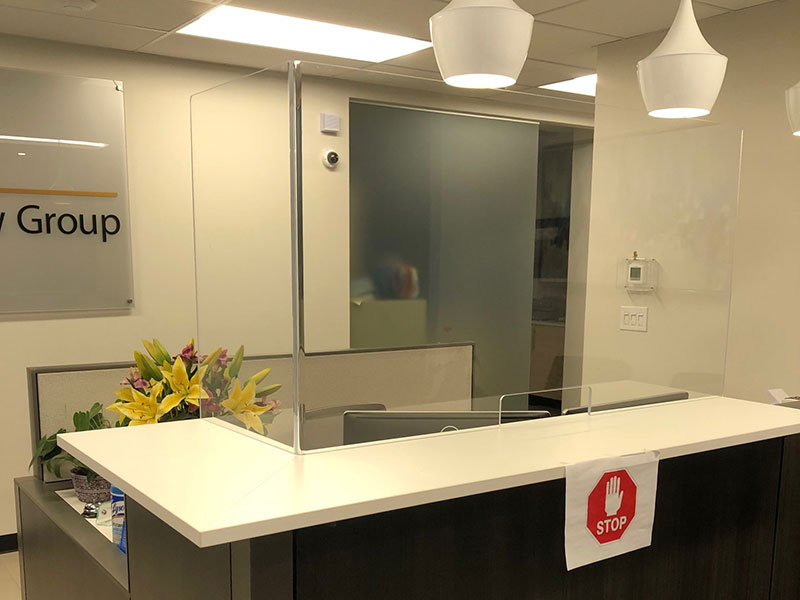Many hospitals around the country are still reeling from the COVID-19 pandemic, and could benefit from the use of transparent barriers. Healthcare facilities need common sense measures in place to slow the spread of infections and protect doctors, patients, and other staff members.

Luckily, plastic fabrication companies can provide some options for these facilities. If you’re looking to upgrade safety conditions at a hospital or health care center, here’s what you should know about the benefits of transparent barriers.
Why Hospitals Need to Be Prepared With Transparent Barriers
COVID-19 cases continue to rise in many parts of the country. At this point, the US has seen nearly 6 million cases. And nearly 300,000 have been reported within the last seven days. States like Florida, Georgia, Texas, and California are leading the way in terms of case volume. And many metropolitan areas within these states see rapid influxes of cases in short periods of time based on activity in the local communities.
Unfortunately, these high case numbers mean that many hospitals have had to make adjustments to their facilities in order to better care for patients in a safe way. Luckily, there are practical and simple ways to improve conditions quickly — including the use of transparent plastic barriers. These barriers are usually constructed using clear, impact resistant plastics like acrylic or polycarbonate. They can be freestanding or attached to nearby walls or ceilings.
Though there isn’t a solution that can completely eliminate the chance of COVID-19 or other infectious diseases spreading from person to person, these barriers can go a long way. Their benefits are clear; they simply provide physical separation between individuals on each side so that infected particles are less likely to travel directly from one person to the other. If an infected patient coughs or sneezes, the partition is likely to stop those infected particles from traveling to the respiratory system of the doctor or nurse treating them. So that individual is less likely to get sick. And they’re also less likely to infect other patients they care for throughout the hospital.
Since hospitals and other healthcare facilities provide services that are absolutely essential, and their care often requires patients and doctors or nurses to interact up close without maintaining the recommended six feet or more of distance between them, these partitions help them interact seamlessly while keeping everyone involved a bit safer.
How Transparent Barriers Can Benefit Hospitals in Both Reception and Patient Areas
So how exactly are hospitals making use of these sneeze guards and other transparent barriers? First, many are installing them over reception desks or intake areas. Since the individuals who check people in for care are likely to see tons of patients in short periods of time, this can prevent those individuals from coming into direct contact with both infected and uninfected persons. Thus, they can help to dramatically slow the spread within a hospital and community.
Additionally, many hospitals are setting up transparent barriers around ICU beds and other patient areas. This can prevent certain care providers from coming into direct contact with individuals who are confirmed positive as well as those who may still be waiting on test results. This can also prevent other nearby patients from coming into contact with infected particles, especially in potentially crowded ICU areas.
These barriers can be easily cleaned and sanitized. And they still give care providers, administrative staff, and patients the ability to see and hear one another from each side of the barrier. This is especially important for doctors who need to perform tests or check patient symptoms and for patients who have questions or concerns.
How Transparent Barriers Can Help in Expansion Areas
Because of the rise and unpredictability of COVID-19 infections in some areas, many hospitals also need to make use of or at least consider the possibility of overflow or expansion areas. These may be temporary locations or hospital sections that are set up to accommodate extra patients, ICU beds, and necessary care accommodations.
Physical barriers between patients and staff can provide the same benefits in these areas as they can in more permanent hospital setups. In fact, it may be even more important to have these types of protections in place in facilities that are experiencing an influx of cases, since that indicates that the hospital may be stretched thin in other ways as well.
Since clear plastic barriers are lightweight and easy to install, they provide a seamless solution for these overflow or expansion areas where they may be needed quickly and for a short period of time. Whether a hospital needs to simply add more ICU beds to a different wing in the same building or set up overflow space at another facility, installing sneeze guards and similar protective solutions should be fairly quick and easy. This is especially important because these changes in case numbers can often occur quickly. And hospital staff don’t have a ton of time to spare when it comes to setting up safety systems to ensure proper patient care.
If you’re looking for a plastic fabrication company to provide transparent barriers and other safety solutions at hospitals, contact Polymershapes to request a free quote. We offer high quality sneeze guards, barriers, and other plastics that are well suited for companies in various industries, including hospitals transportation providers, retail establishments, energy companies, and even schools. Our Dayton fabrication center is outfitted with state of the art machining equipment. So we can offer expert conversion capabilities and customize safety solutions to meet your facility’s needs. And our team is always available to answer questions and help clients choose the right products and materials. To discuss transparent barriers or other plastic fabrication options, simply visit our website and request a quote. And we’ll get back to you within 24 hours.